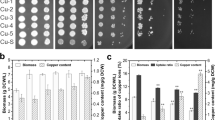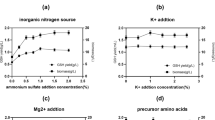Abstract
Zinc is an essential trace element for many physiological functions in humans and animals. We have previously reported on the isolation of zinc-enriched Saccharomyces cerevisiae FF-10 from the tropical fruit Rambutan (Nephelium lappaceum L.). The present study was undertaken to investigate the influence of the optimal medium composition pertaining to carbon and nitrogen sources, amino acids, minerals, and different zinc compounds on zinc accumulation in FF-10 strain. The highest accumulation of zinc was obtained in a medium containing 2.0%(w/v) glucose, 5.0% yeast extract, and 0.05% ZnSO4 after cultivation at 110 rpm, 30°C, 72 h. Under these conditions, the 31,932 ppm zinc represented a 93-fold increase over the 339 ppm in the basal medium. The accumulation of zinc in yeast cells increased with the increase of supplemented concentrations (250–4,000 ppm) of zinc powder, zinc sulfate, zinc acetate, and zinc chloride in the culture medium, with the greatest accumulation evident at 4,000 ppm of zinc sulfate, zinc acetate, and zinc chloride. The zinc concentration in the medium strongly influenced FF-10 strain growth. In the presence of medium supplemented with 4,000 ppm zinc chloride, zinc accumulation by FF-10 strain increased by 445-fold to 150,892 ppm. From these results, the beat medium compositions for zinc accumulation in FF-10 yeast were obtained after cultivation with for 72 h in a medium containing 2% glucose, 5% yeast extract, and 0.04% ZnCl2.
Similar content being viewed by others
Abbreviations
- CFU:
-
colony forming unit
- DCW:
-
dry cell, weight, FF-10, Saccharomyces cerevisiae FF-10
- RDI:
-
recommended daily intake
References
Alfafara CG, Kanda A, Shioi T, Shimizu H, Shioya S, and Suga K (1992) Effect of amino acids on glutathione production by Saccharomyces cerevisiae. Appl Microbiol Biotechnol 36, 538–540.
Alonso J, Garcia MA, Perez-Lopez M, and Melgar MJ (2003) The concentrations and bioconcentration factors of copper and zinc in edible mushrooms. Arch Environ Contam Toxicol 44, 180–188.
Baltaci AK, Mogulkoc R, and Ozturk A (2006) Testosterone and zinc supplementation in castrated rats: Effects on plasma leptin levels and relation with LH, FSH and testosterone. Life Sci 78, 746–752.
Black RE (2003) Zinc deficiency, infection disease and mortality in the developing wold. J Nutr 133, 1485S-1489S.
Boch A, Trampcznska A, Simm C, Taudte N, Kramer U, and Clemens S (2008) Loss of Zhf and the tightly regulated zinc-uptake system SpZrt1 In Schizosaccharomyces pombe reveals the delicacy of cellular zinc balance. FEMS Yeast Res 8, 883–896.
Brewer GJ (2001) Zinc acetate for the treatment of Wilson’s disease. Expert Opin Pharmacother 2, 1473–1477.
Cha JY, Heo JS, Kim JW, Lee SW, and Cho YS (2008a) Isolation and identification of zinc-enriched yeast Saccharomyces cerevisiae FF-10 from the tropical fruit Rambutan. J Life Sci 18, 114–453.
Cha JY, Heo JS, Park BK, and Cho YS (2008b) Effect of zinc-enriched yeast supplementation on serum zinc and testosterone concentrations in ethanol feeding rats. J Life Sci 18, 947–951.
Cha JY, Park JW, Jeon BS, Lee YC, and Cho YS (2004) Optimal fermentation conditions for glutathione production by Saccharomyces cerevisiae FF-8. J Microbiol 42, 51–55.
Chen C and Wang JL (2007) Characteristics of Zn2+ biosorption by Saccharomyces cerevisiae. Biomed Environ Sci 20, 478–482.
Daz-Gmez NM, Domnech E, Barroso F, Castells S, Cortabarra C, and Jimnez A (2003) The effect of zinc supplementation on linear growth, body composition, and growth factors in preterm infants. Pediatrics 111, 1002–1009.
Elless M, Blaylock M, Huang J, and Gussman C (2000) Plants as a natural source of concentrated mineral nutritional supplements. Food Chem 71, 181–188.
Gimmler H, Jesus J, and Greiser A (2001) Heavy metal resistance of the extreme acidotolerant filamentous fungus Bispora sp. Microb Ecol 42, 87–98.
Hambidge M (2000) Human zinc deficiency. J Nutr 130(S), 1344–1349.
Ho E and Ames B (2003) Zinc deficiency induces DNA damage and compromises DNA repair signal pathways in C6 glioma cells. J Nutr 133(S) 203E-282E.
Izu H, Shobayashi M, Manabe Y, Goto K, and Iefuji H (2006) S-adenosylmethionine (SAM)-accumulating sake yeast suppresses acute alcohol-induced liver injury in mice. Biosci Biotechnol Biochem 70, 2982–2989.
Kagaya N, Kawase M, Maeda H, Tagawa Y, Nagashima H, Ohmori H, and Yagi K (2002) Enhancing effect of zinc on hepatoprotectivity of epigallocatechin gallate in isolated rat hepatocytes. Biol Pharm Bull 25, 1156–1160.
Kalae P and Svoboda L (2000) A review of trace element concentrations in edible mushroom. Food Chem 69, 273–281.
Kapoor A and Viraraghvan T (1995) Fungal biosorption-an alternative treatment option for heavy metal bearing wastewaters: a review. Biooresour Technol 53, 195–206.
Kim HM, Park SY, Ra KS, Koo KB, Yun JW, and Choi JW (2006) Enhanced production of exopolysaccharides by fed-batch culture of Garnoderma resinaceum DG-6556. J Microbiol 44, 233–242.
Lakatos B, Szentmihalyi K, Vinkler P, Balla J, and Balla G (2004) The role of essential metal ions in the human organism and their oral supplementation to the human body in deficiency states. Orv Hetil 145, 1315–1319.
Lee NH, Im MH, and Choi UK (2006) Calcium absorption by the fruitbody of Saesongi (Plesurotus eryngii) mushroom. Food Sci Biotechnol 15, 308–311.
Li Y, Chen J, Zhou N, Fu W, Ruan W, and Lun S (1998) The effect of environmental conditions and glucose feeding strategy on glutathione (GSH) production. Chin J Biotechnol 14, 85–91.
Miles R and Henry P (2000) Relative trace mineral bioavailability. Ciencia Anim Brasileira 1, 73–93.
Motoi H and Suzuki Y (2004) A water soluble natural zinc source prepared from defatted wheat germ. Food Sci Biotechnol 13, 17–20.
Muter O, Lubirya I, Millers D, Grigorjeva L, Ventinya E, and Rapoport A (2002) Cr(VI) soption by intact and dehydrated Candida utilis cells in the presence of other metals. Process Biochem 38, 123–131.
Pankiewicz U and Jamroz J (2007) The effect of pulse electric field on accumulation of selenium in cells of Saccharomyces cerevisiae. J Microbiol Biotechnol 17, 1139–1146.
Paola L and Albergoni V (2005) Interaction between copper and zinc in metal accumulation in rats with particular reference to the synthesis of induced-metallothionein. Chem-Biol Interact 155, 155–164.
Park JC, Ok M, Cha JY, and Cho YS (2003) Isolation and identification of the glutathione producing Saccharomyces cerevisiae FF-8 from Korean traditional rice wine and optimal producing conditions. J Korean Soc Agric Chem Biochnol 46, 348–352.
Park JP, Kim SW, Hwang HJ, and Yun JW (2001) Optimization of submerged and exo-biopolymer production by Cordyceps militaris. Lett Appl Microbiol 33, 76–81.
Puranik P and Paknikar K (1999) Biosorption of lead, cadmium, and zinc by Citrobacter strain MCM B-181: Chatacterization studies. Biotechnol Prog 15, 228–237.
Rabinovich M, Figlas D, Delmastro S, and Curvetto N (2007) Copper- and zinc-enriched mycelium of Agaricus blazei Murrill: Bioaccumulation and bioavailability. J Med Food 10, 175–183.
Rojas L, McDowell L, Cousins R, Martin F, Wilkinson N, Johnson A, and Velasquez J (1996) Interaction of different organic and inorganic zinc and copper sources fed to rats. J Trace Elim Med Biol 10, 139–144.
Sandstead HH (1995) Is zinc deficiency a public health problem? Nutr 11, 87–92.
Shin WC, Kim DS, Yu JH, and Yu JH (1993) Isolation, identification and culture condition of microorganism producing glutathione. Korean J Appl Microbiol Biotechnol 21, 1–5.
Sivaraj SV, Osborne J, Madhaiyan M, Mathew L, Chung J, Ahn K, and Sa T (2007) Zinc metal solubilization by Gluconaceter diazotrophicusand induction of pleomorphic cells. J Microbiol Biotechnol 17, 1477–1482.
Strouhal M, Kizek R, Vacek J, Trnkova L, and Nemec M (2003) Electrochemical study of heavy metals and metallothionein in yeast Yarrwia lipolytica. Bioelectrochem 60, 29–36.
Tachiyashiki K and Imaizumi K (1994) Effects of dried yeast on the body weight, serum cholesterol levels, and perirenal and periepididymal adipose tissue cells in rats. J Jpn Soc Nutr Food Sci 47, 219–226.
Take A, Yano K, Suzuki Y, and Noda K (1997) Magnesium, manganese, zinc and copper contents in Japanese foodstuffs. J Jpn Soc Nutr Food Sci 30, 381–393.
Turto J, Gutkowska B, Kalucka M, and Bujak M (2007) Accumulation of zinc by the Lentinus edodes(Berk.) mycelium cultivated in submerged culture. Acta Pol Pharm 64, 45–51.
Wada L and King TC (1986) Effect of low zinc intake on basal metabolic rate, thyroid hormones and protein utilization in adult men. J Nutr 116, 1045–1053.
Werner A and Beelman R (2001) Growing selenium-rich mushrooms by adding controlled amounts to the compost at spawning. Mushroom News 49, 4–11.
Zachariadis GA, Raidou ES, Themelis DG, and Stratis JA (2002). Determination of mineral content of active dry yeast used in pharmaceutical formulations. J Pharm Biomed Anal 28, 463–447.
Author information
Authors and Affiliations
Corresponding author
Rights and permissions
About this article
Cite this article
Cha, JY., Cho, YS. Determination of optimal conditions for zinc-hyperaccumulation by Saccharomyces cerevisiae FF-10. J. Korean Soc. Appl. Biol. Chem. 52, 227–233 (2009). https://doi.org/10.3839/jksabc.2009.041
Received:
Accepted:
Issue Date:
DOI: https://doi.org/10.3839/jksabc.2009.041




